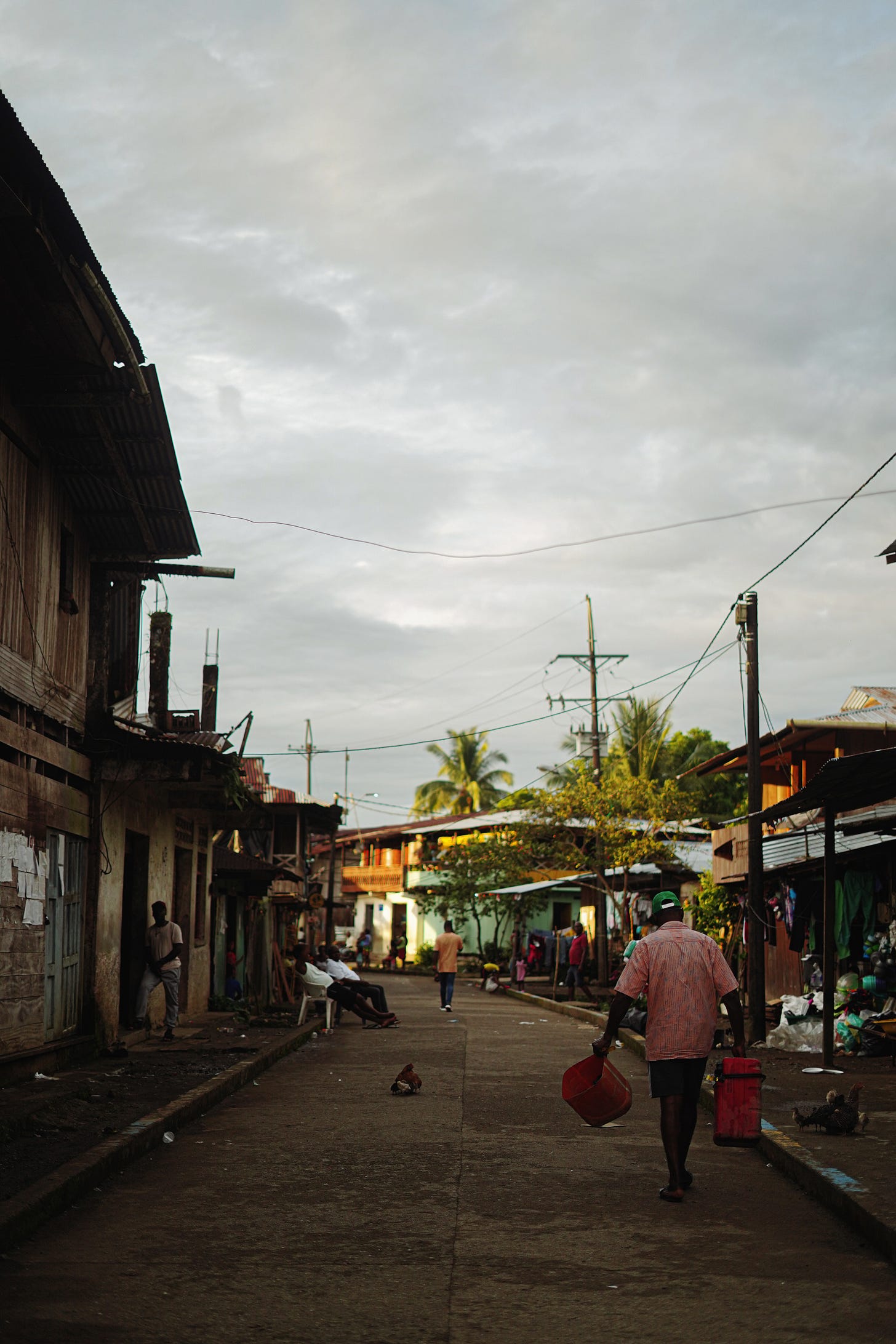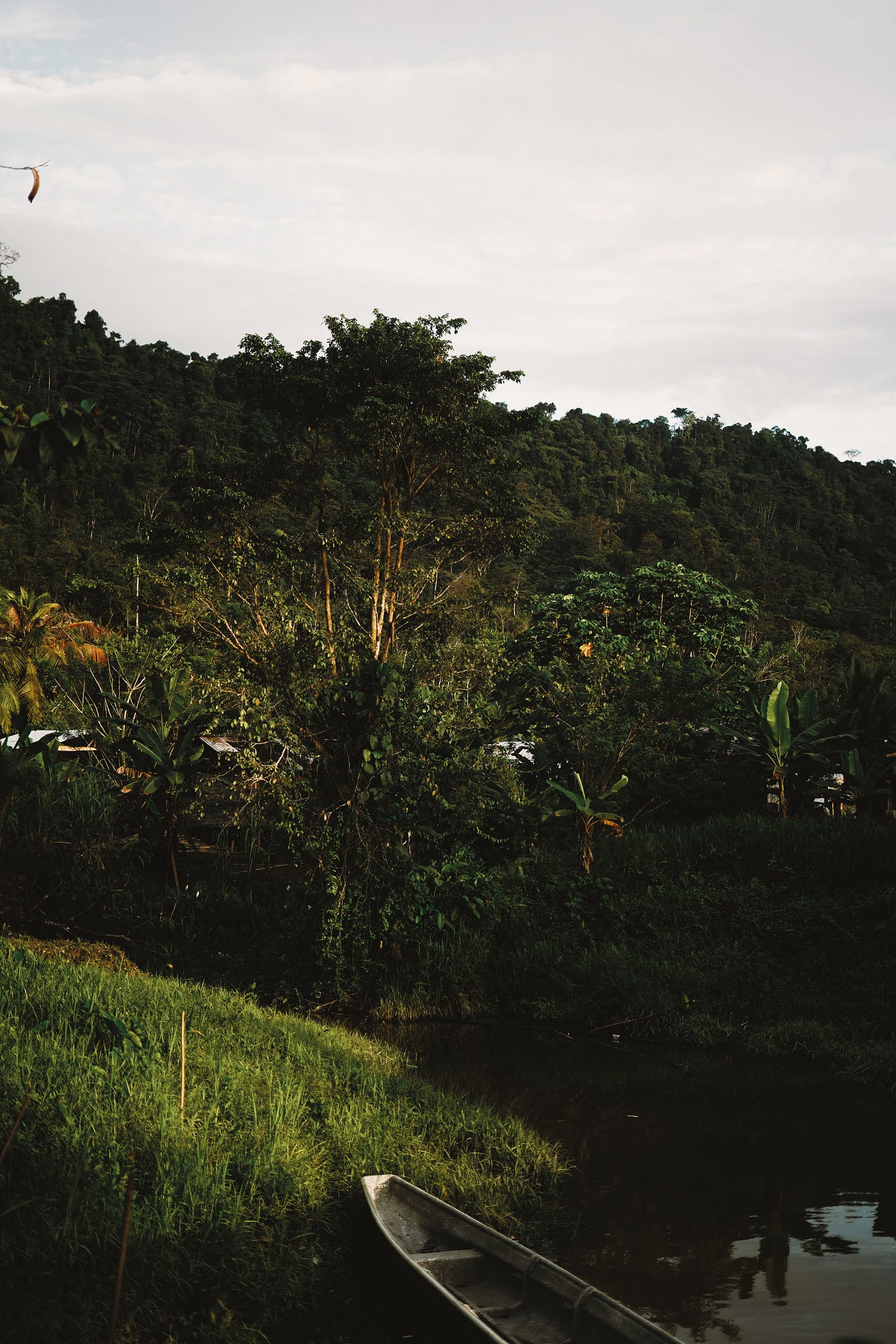Ship´s Log: conflict observations from the Jungles of Chocò
Our thoughts as we navigate the river labyrinths speak to forgotten communities, and see the conflict-region first-hand
Daniela and Joshua have been accompanying Medicos Sin Fronteras this week to jungle regions of Chocò, by boat, by truck, and on foot. Rather than write the regular newsletter, we thought it is the perfect moment to share a “behind the scenes” look at the coverage we will be producing over the next few weeks as part of this extensive ( and at times exhausting) journey.
Usually, the “Ship´s Log” is reserved for paid subscribers, but this week we wanted to give everyone a glimpse. If you like what you read, or if you want to support more independent journalism in Latin America, please consider taking out a paid sub. They start at just $5 per month.
And if you are already part of the “officers class” subscription level, thank you again for your support.
Ship´s Log: conflict observations from the Jungles of Chocò
Our thoughts as we navigate the river labyrinths speak to forgotten communities, and see the conflict-region first-hand
The village of Pie de Pató, in the conflict-torn department of Chocó, Colombia is 8 to 12 hours away from the closest point of medical attention, depending on how high the river is.
The Baudó river is the principal transportation corridor in the region: despite being inland in the northwestern region of the country, there are no roads that reach this community. Unlike many other conflict areas that Pirate Wire Services has reported from, however, there is at least some footprint of state presence in this village of more than 30,000 in the form of heavily armed soldiers patrolling the streets.
We have been invited to accompany a field mission conducted by Medicos Sin Fronteras (Doctors Without Borders), which provide medical attention to communities far removed from hospitals or any other emergency care providers- and regions that are directly controlled by criminal armed groups that battle in the region for territorial control.
Although a host of gangs and criminal structures operate in the region, the two largest, by far are the leftist rebel group National Liberation Army (ELN) and the Gaitanista Self-Defense Forces of Colombia (AGC), also known as the Clan del Golfo, who descend from the right-wing paramilitary forces who fought on the side of the government during the country’s 52-year civil war.
Intense fighting between the groups in recent years has led to mass displacements of entire communities. Perhaps just as dangerous for the people who live here, however, are the lockdowns imposed by the armed groups who fight in the region.
When the ELN and AGC go to war in the region, they often announce to the communities in the regions where confrontations are occurring that anyone out of their homes will be considered an enemy combatant, and risk being shot on sight.
The Colombian state, as well as NGOs in the region, call these lockdowns “forced confinements”. In 2022, a total of 433.580 people in Colombia were confined to their homes due to violence or threats of violence.
For indigenous pueblo* like the Emberá, these lockdowns quickly become a matter of life and death.
“We can’t hunt. We can't harvest our crops, which are often grown on the shores of the river [where armed groups are likely to be patrolling],” said an indigenous leader who asked that we not print his name for fear he could be killed by armed groups for speaking out.
Conflict makes basic economic activity impossible, often presenting indigenous communities with an impossible solution- bullets or slow starvation.
“This conflict does not have anything to do with us,” continues the leader. “These fighters need to return to their homes, so we can return to ours.”
Indigenous and afro communities trapped in the crossfire of the Colombian conflict have suffered deaths, forced recruitment, sexual violence, gender-based violence in addition to the displacements and forced confinements of entire communities mentioned above.
We will be reporting in detail on those topics, as well as the efforts of humanitarian organizations in the region to meet the increasingly dire needs of the communities caught in the crossfire of this regional conflict. But in keeping with the spirit of the “Ship´s Log” entries here at PWS, we thought for this particular piece we would also give readers a behind-the-scenes look at how our reporting trip went, and what impacted us the most.
Militarization upriver, “No-man´s land” below
Joshua’s reactions to Chocó river life
Puerto Meluk, where our land journey ended, and our speedboat journey began, is a river town strictly under the control of AGC. In fact, in all the time I have spent in areas controlled by armed groups, I have never seen a town with so much graffiti proclaiming the presence of those who control it.
Every shop, nearly every house, and every business in the riverside port town has been painted with variations of “AGC”. One cannot walk 10 meters in Puerto Malùka without encountering their territorial markers. The police station showed obvious signs of having been attacked: bullet holes in the exterior as well as chunks missing from the fortified roof, presumably from explosions.
Heavily armed soldiers patrolled the town, as well as maintained a checkpoint near the entrance. Despite this militarization, however, AGC seemed undeterred from maintaining an open presence.
Four hours south by motorboat to Pie de Pato, and the disparity between the community and the state became even more clear. Despite a lack of potable water, any health care facilities, or other signs of the Colombian state, heavily armed (and armored) soldiers came and went via helicopter during our stay.
Another two hours south by river, at a mostly indigenous community called Santa Catalina de Catrú, there was no semblance of a state at all- with even the military seemingly afraid to maintain a presence.
I´ve often read the argument that conflict cannot be truly ended without some form of support from Colombian security forces. Perhaps that is true, but the military alone cannot resolve these problems in regions plagued by armed groups. In Pie de Pato for example, we were told that the heavy presence of soldiers may prevent open fighting in the premises of the small town itself, but they often fight in surrounding regions, or just downriver, where security forces fear to tread.
My biggest conclusions from this trip were that despite what the government may claim, there are no meaningful ceasefires between the government and these groups, nor (at least so far) is the government trying new strategies of peace-building aside from militarization.
Deploying troops to occupy villages as if they were hostile invading forces is a strategy that has been tried for half a century here. It clearly hasn't worked, at least as a stand-alone, long-term strategy.
Another Colombia that deserves to be heard
Daniela’s reactions to Alto Baudó life
My colleague Josh, puts the word 'Peace' on the table. This term means a lot of different things. But the important question to me is what “peace” means to those who live in the Upper, Middle, and Lower Baudó, the very regions we are visiting. Peace for these communities does not only mean a ceasefire or the withdrawal of armed groups from their territories but rather the broad concept of peace has a much deeper meaning.
It is difficult to think of a 'Total Peace' [as Colombian President Gustavo Petro has called it] that does not include justice and the basic right to a dignified life for all peoples. If there is a ceasefire, it must also be accompanied by guarantees that residents will have free movement within their communities, treatment for basic health problems, or even more simply, a home that does not flood every time the river rises. Perhaps for many of the people who live 4, 6 or 8 hours away from the headwaters, peace is a foreign word because they have always lived deliberately marginalized and without basic access to essentials that most people in the world take for granted such as health and food.
As we traversed the river for hours, we had plenty of time to contemplate the beauty of the breathtaking displays of nature that have been hidden from us by years of violence. My thoughts on the matter are a multitude that I cannot properly communicate merely through words in this small space. But I return with the absolute certainty that in the midst of all the despair we witnessed, hope and humility persist, and there is another Colombia, on the margins of the one you hear about every day in the news, that demands to be heard, demands to live in decent conditions.
And we must listen.





Thank you for the insight into your impressions from this journey! <3
(Just a tiny thing: I think NAME wanted to be replaced by the actual person's name ^^)